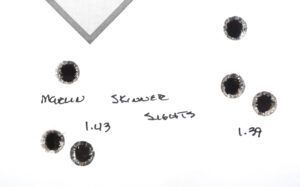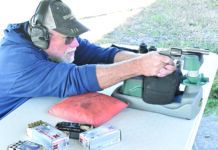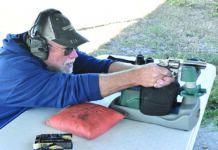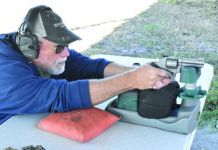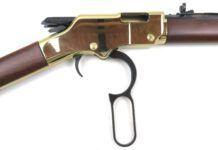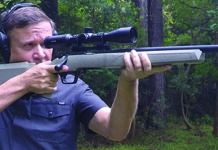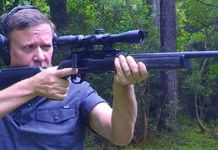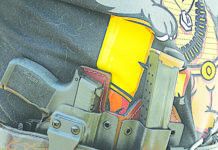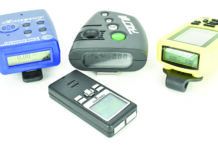In the July 2024 printed edition of Gun Tests, we tested a Ruger-made Marlin 1894 Classic in 44 Special/44 Remington Magnum Model No. 70401 head to head against the just-released Smith & Wesson 1854 Lever Action Rifle in 44 Mag. At the same time, we also fired a Legacy Marlin Model 1894 ($800 on Gunbroker.com) made in 2008, per serial number databases. The last of the Marlin or Remington/Marlin made rifles had a reputation for problems and poor accuracy. We needed to see if those reports were valid, if Ruger properly addressed those issues and if those who had been scared off by some of the reports from years ago needed to reconsider buying this redesigned Marlin.

We’ve tested Marlin 1894 models for more than 25 years. As far back as the May 1997 issue, we reviewed a Marlin 1894S in 44 Magnum and said, “The Marlin Model 1984S could have had a smoother action. Nevertheless, our shooters thought it was a good performer. We recommend this 44 Magnum rifle.” In the October 2002 issue, we evaluated a Marlin 1894CB rifle in 357 Magnum, saying it’s “a slick rifle that got slicker with use, the octagonal-barrel Marlin would fit into any Cowboy Action Shooter’s saddle boot. It could do double duty as a small-game rifle with the easy addition of a scope. We liked the balance, wood quality, looks and overall workmanship of this traditionally made rifle.” In the January 2006 issue, we evaluated a Marlin 1894 in 44 Magnum and said “Don’t Buy” it because, reviewed in the context solely of self defense against a Winchester 94 Trapper 44 Magnum, a Ruger Deerfield in 44 Magnum, and a KelTec Sub Rifle 2000 in 9mm Luger, we said “the Trapper simply outdoes the Marlin. Because the Winchester costs less and does slightly more, we wouldn’t buy the Marlin unit.” One of the complaints we’ve had about the 1894 Marlins over the years has been the buckhorn open sights. Those are not known for being the easiest sights for mature eyes to shoot accurately, so we acquired a set of Skinner peer sights and installed them on the Legacy Marlin. Then we reshot the accuracy test using the Black Hills 240-grain JHP, looking for improvement.

Smith & Wesson laid claim to the first commercially successful lever action firearm with the Volcanic pistol in 1854. History gives Benjamin Tyler Henry credit for inventing and patenting the 1860 Lever Action rifle. Nelson King improved on the Henry with his Model of 1866, adding in a side loading gate and some protection for the magazine tube. The Model of 1873 took another giant leap forward with a toggle link housed in a steel frame. Oliver Winchester had the great foresight and business acumen to back Henry and King.
Winchester wasn’t the only company in the lever action rifle business. By 1881 John Marlin, a former gun builder for Colt, had been out on his own more than 10 years, primarily building single-shot pistols and rifles. He introduced his own side-loading, top-eject rifle with a receiver and action solid enough for big-bore cartridges like the 45-70 and the 38-55. In 1889 he brought out a new model, this time with both side-loading and side-eject, thus sporting a stronger system that yielded benefits we still enjoy today. The 1893 model introduced the locking block and two-piece firing pin still featured in many current models. The 1894 model scaled things back for those handy little pistol-caliber cartridges. We wish we could have ended that last paragraph with “and they never looked back,” but they did. WWI brought tremendous opportunity but left Marlin with equally tremendous problems when it ended. Production requirements and the resulting capital expenditures had increased exponentially during the way years. The end of the war, and all those cancelled orders, left many firearms manufacturers in serious financial trouble. We’ve seen at least three changes in Marlin ownership over the decades, with the last coming when Remington (and the holding company that owned them and Marlin) filed for bankruptcy.
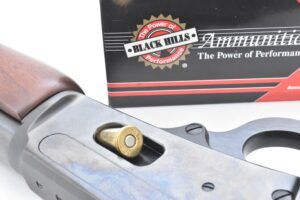
Marlin Legacy 1894 44 Special/44 Remington Magnum (2008), $800
By the 1890s the concept of a lever action firearm wasn’t exactly new. Even the aforementioned Henry rifle of 1860 was predated by the Smith & Wesson “Volcanic” lever action pistol from 1854. The lever action repeater brought an amount of firepower unimaginable a short time before. Deemed “that Damned Yankee rifle they could load on Sunday and shoot all week” by the Johnny Rebs, the 1869 Henry played a sizeable role in the War Between the States. Never officially adopted by the North, many a Militia General or Colonel recognized the capabilities thereof and purchased them for their men using private funds. Accounts of their effectiveness in battle can easily be found.
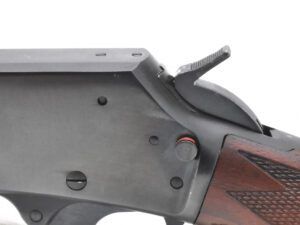
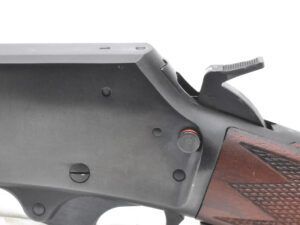
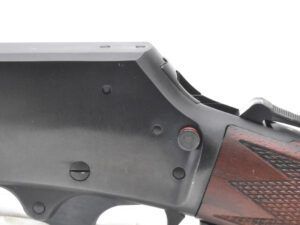
As revolutionary as these rifles were, they still had a number of shortcomings that needed to be worked through. The early models were made of brass or iron. These softer alloys limited the power of the cartridge they could safely contain. That said, this was not a huge issue at the time since self-contained cartridge development was still in its infancy and the repeating rifles of the time (including the Spencer) used mild rimfire cartridges. The Henry rifle may have had a 16-round magazine tube, but it did not use the handguard we are so familiar with today. Instead, the spring-loaded tube was somewhat open to the elements and very subject to damage, effectively leaving the owner with a single shot firearm.
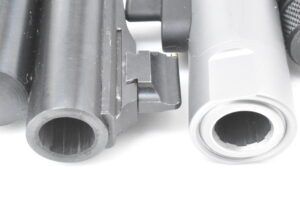
The Winchester 1873 corrected many of those problems with an alloy steel construction and a wooden handguard covering much of the magazine tube. The lever throw was fast and smooth – go try one of the currently manufactured Winchester or, especially, on the Uberti 1873’s with the short-stroke lever kit designed for Cowboy Action competition. Even with better steel, the toggle action lock that was used still limited the power of the cartridge employed therein. The cartridge itself had come a long way since 1860. Gone was the rimfire priming system and the spotty ignition that provided. The first Winchester model was chambered in 44 WCF (Winchester Center Fire) which was a huge improvement in energy over the 44 Rimfire. Versions from short-barreled carbines to full-length rifles were available for the asking (and a different price based on the length and style of the barrel).
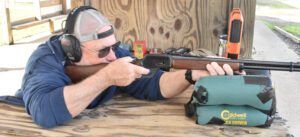
The advent of smokeless gun powders in the 1890s changed the capabilities of firearms forever. The new mixtures increased the pressure that were possible from the propellants and, so, what we could ask the bullets to do. That also meant that, once again, new alloys had to be developed along with new heat treatments for the steel. Winchester led the process with the introduction of their Model 1892 rifle. Initial chamberings were 44-40, 38-40, 32-20 and 25-20. They’ve learned to do a lot more with it since.
Marlin introduced their smokeless powder capable, pistol caliber lever action in 1894. Chambered for most of the same cartridges as the Winchester 1892, the Marlin 1894 brought some of their own improvements to the market. Perhaps the change still noticed the most by today’s shooters will be the side eject versus the top eject still present in Winchester models. We understand that this allows for an even stronger action than their predecessors and it helps keep debris from getting into the action.
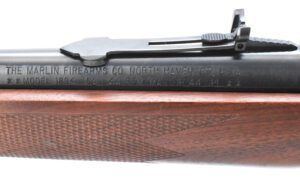
The side eject also allows for a solid top strap that has ramifications for todays’ shooters not dreamed of in 1894. That being the option of optical sights. Today’s cartridges will go farther and shoot flatter, but that doesn’t do us any good if we can see to guide them. The solid top strap on our Marlin 1894 has been tapped and drilled for four screws with a spacing that, we understand, has become industry standard. A sight or scope mount that will fit a Marlin 1894 should also fit a Henry, Rossi or even a Winchester 1895.
We obtained a set of Skinner Express sights and mounted them on the Legacy Marlin for a second shooting test. All we had to do was take out the four screw plugs (you really only have to remove the two at the front and the rear) and used the provide socket head screws to attach the mount. The mount bar is dovetailed for a brass piece that holds a peep sight. The sight ring is also brass, but the replaceable aperture (available in different sizes) was a non-reflective black. The new front sight fits in the original dovetail. Be aware that their front sights blades come in various heights (we used a .450 in.) and you might want to talk to them about what is best for your rifle. The new blade was oversized (as it should be) and required a few minutes work with a triangle file to make it fit (remember to work on the sight, not the dovetail).
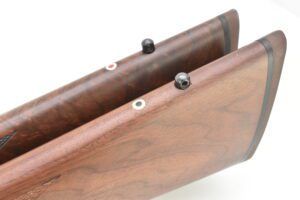
With the height of the new sight, we found that could not reinstall the factory front sight hood, but that was no big deal. BTW, the rear sight also needs to be removed for everything to work right and the Skinner set includes a plug for the now-empty rear sight dovetail. The Skinner rear peep and brass bead front sight allowed us to essentially ignore the rear sight and focus strictly on the front sight and target. Sight acquisition was much faster as well. We then tested using the same targets as with the original sights and with the same Black Hills ammo looking specifically for an improvement in speed and group size. The Skinner’s did not disappoint.
The rest of our Legacy Marlin stayed in a strictly original configuration. The stock is black walnut with a bit of grain showing. The pressed checkering looked good on the fore end, but the buttstock left a bit to be desired. The design was good, but the tips were rounded, and crosshatching was common. Wood to metal fit was also good, but it showed to be a tighter fit at the end of the tang than where the receiver met the muzzle end of the buttstock – something that Ruger engineers told us was a problem that they had to fix. The metal is matte blue and an even finish. No tool mark were visible and the receiver walls were smooth and flat. The magazine tube will allow the loading of 10 rounds of 44 Mag ammo or 11 rounds of 44 SPL. A sling swivel stud is mounted on a barrel band at the very front of the fore end, and another is mounted in the buttstock.
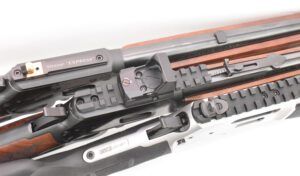
Understanding that this may be an over-generalization, there seem to have been four periods in the history of the modern Marlin 1894: 1). The original guns as designed and produced by Marlin 2). Those produced by Remington after their purchase of Marlin (2007) but before problems became obvious 3). Problem years where experienced workers were less common and too many bean counters were running production 4). Ruger purchases Marlin (2020) and takes over with their model. Our Legacy seems to date to very early period Two and we needed to see how it performed. Our lever operated smoothly with no signs of excess wear. The magazine tube worked well, and the loading gate was easy to use. We were ready for the gate to bind or shave metal on loading but that was not the case. Required trigger compression was fine at 4.55 lbs. (the Ruger/Marlin was 4.29 lbs.) without much creep but a lot of overtravel. The crossbolt safety, love it or hate it, did its job and totally blocked the hammer from contacting the safety. You can always use the half-cock notch if so desired.
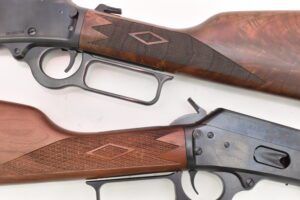
This group has invested heavily in 44 caliber pistols and rifles over the years. As a result, our shelves had quite the selection of bullet weights and styles from which we could select. We tried them all – round nose, flat nose, JHP, semi-wadcutters, you name it, we tried it. The old Marlin fed everything we put through with aplomb, with the possible exception of the 320 grain Hardcast flat point loaded by Doubletap. The load was very accurate notching a single, incredible .64 in. group at 50 yards. That said, there were a few times we had to jiggle the lever just a bit to get that big nose to feed. Average group size at 50 yards was 2.43 in. using the factory buckhorn sights.
Marlin 1894 (2008) 44 Remington Magnum, $800
Grade B
A great rifle and a nice piece of history, we would be proud to have this in our collection. However, the new Marlin by Ruger is better.
Action Type Lever
Overall Length 37.6 in.
Barrel Length, Twist 20.25 in., 1:20
Overall Height w/o Scope Mount 8.1 in.
Weight Unloaded 6.14 lbs.
Weight Loaded 6.73 lbs.
Sight Radius 16.9 in.
Action Finish Satin Blue
Barrel Finish Satin Blue
Magazine Capacity 10 (44 Mag), 11 (44 Spl)
Magazine Type Tube
Stock Black Walnut
Drop at Comb 1.25 in.
Drop at Heel 2.0 in.
Bedding n/a
Buttplate Rubber
Length of Pull 13.6 in.
Receiver Scope-Base Pattern Marlin 1894
Trigger Pull Weight 4.55 lbs.
Safety Hammer and cross bolt
Warranty n/a
Telephone n/a
Website n/a
Made In USA
44 Magnum Range Data
Hornady Legacy Marlin 1894 S&W
Monoflex 200 grn. Marlin Classic (Ruger) Model 1854
Average Velocity 1589 fps 1622 fps 1680 fps
Muzzle Energy 1121 ft.-lbs. 1169 ft.-lbs. 1253 ft.-lbs.
Average Group 2.74 in. 2.4 in. 2.29 in.
Best Group 1.68 in. 1.77 in. 1.91 in.
Doubletap Legacy Marlin 1894 S&W
320 grn. Hard Cast Marlin Classic (Ruger) Model 1854
Average Velocity 1591 fps 1626 fps 1663 fps
Muzzle Energy 1800 ft.-lbs. 1879 ft.-lbs. 1964 ft.-lbs.
Average Group 2.04 in. 2.24 in. 2.36 in.
Best Group 0.64 in. 1.58 in. 1.98 in.
Black Hills Legacy Marlin 1894 S&W
240 grn. JHP Marlin Classic (Ruger) Model 1854
Average Velocity 1665 fps 1655 fps 1676 fps
Muzzle Energy 1477 ft.-lbs. 1460 ft.-lbs. 1496 ft.-lbs.
Average Group 2.52 in. 2.05 in. 1.55 in.
Best Group 2.36 in. 1.37 in. 1.53 in.
Replacement Sights
To see how better sights might affect the downrange results of the Marlins, we replaced the Legacy Marlin’s sights with a Skinner Express sight set. For the new Marlin Classic, we added a Midwest Industries Picatinny rail (No. 720836, $37, MidwayUSA.com) and a Crimson Trace RAD (Rapid Aiming Dot) Pro 01-01940, $269 from OpticsPlanet.com. The RAD has a 3-MOA red dot and may be designed for a pistol, but it also comes with a low mount designed to attach to a Picatinny rail.
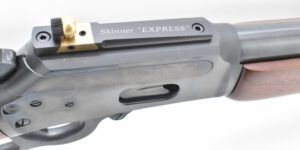
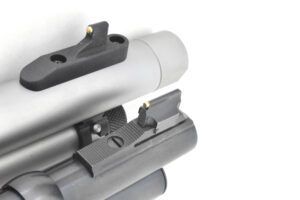
Black Hills Marlin Marlin 1894
240 grn. JHP Skinner Classic (Ruger) Red Dot
Average Velocity 1665 fps 1655 fps
Muzzle Energy 1477 ft.-lbs. 1460 ft.-lbs.
Average Group 1.41 in. 0.96 in.
Best Group 1.39 in. 0.68 in.
We conducted our tests at American Shooting Centers in Houston. At 50 yards, we fired multiple three-shot groups for accuracy from a well-sandbagged Caldwell TackDriver Pro rest (Brownells 100-027-023, $49), further supported by a large rear bag, heavy from Tab Gear (TabGear.com, $34). Our 44 Remington Magnum loads covered the weight and power spectrum with Hornady Handgun Hunter 200-grain Monoflex all-copper rounds, Black Hills Factory New 240-grain JHPs, and Doubletap 320-grain Hardcast Solid lead cartridges. We did function testing with a surplus of 44 Magnum reloads we had on hand.
